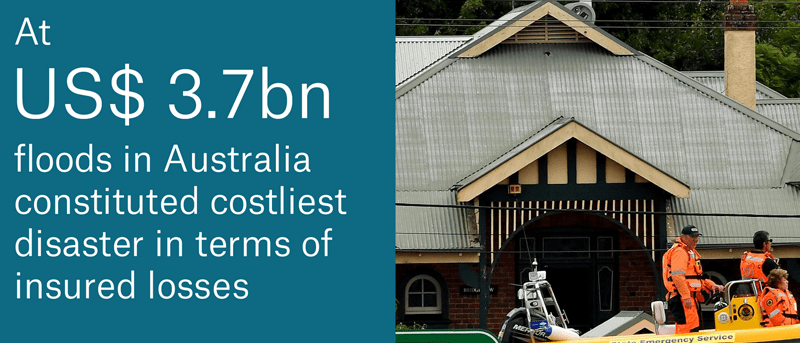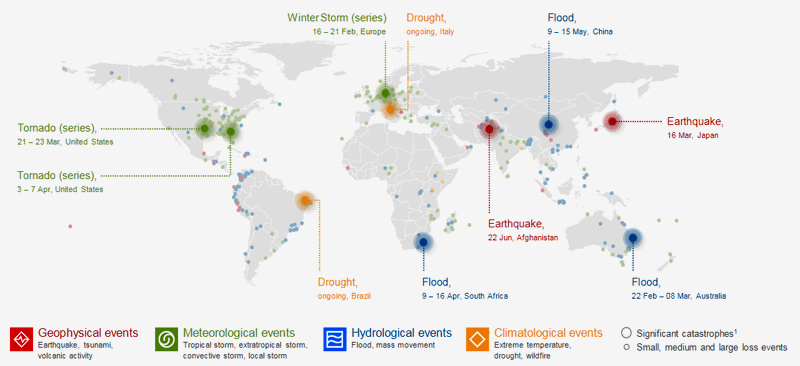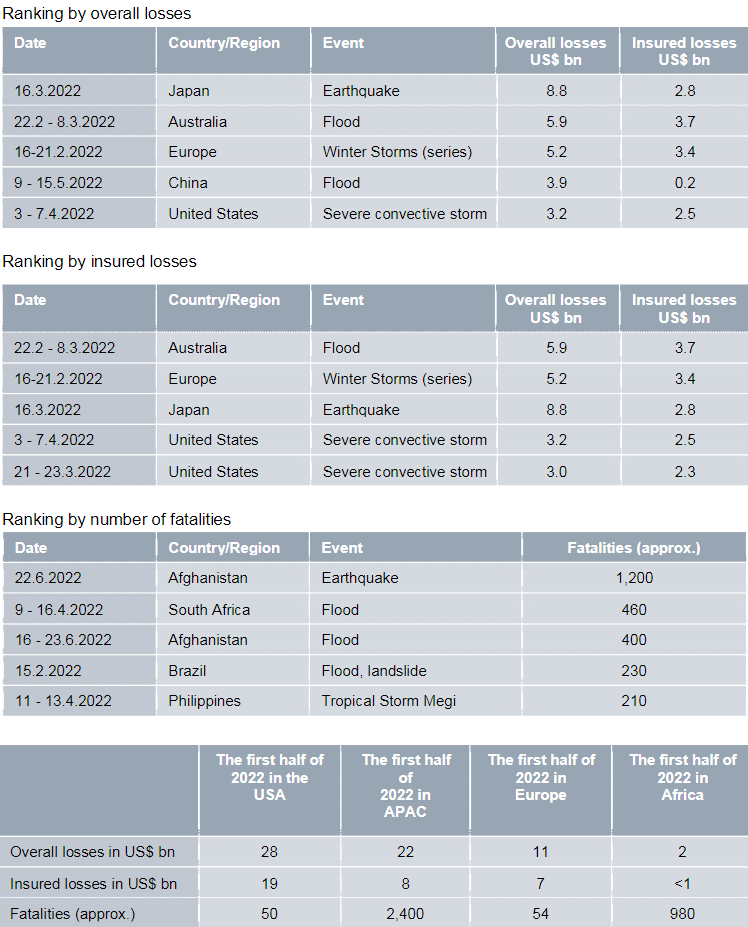US led the way in the 2022 with the highest level of weather-related losses, which, globally, reached $130 billion in the period, of which more than 50% were covered by insurance.
Weather-related Events drove economic losses of $130 bn, with insured losses staying roughly the same at approximately $70 bn
According to Munich Re, 2022 natural disaster review examines a period dominated by weather-related catastrophes in numerous parts of the world.
The Key Takeways
- In the first half of 2022, natural disasters caused overall losses of US$ 65bn, with slightly more than half of these insured
- Extreme multi-day rainfall and severe flooding in Australia constituted the main loss burden for the insurance industry of at least US$ 3.7bn
- US once again country with highest weather-related losses
- Number of fatalities from natural disasters increased to 4,300 compared with first half of 2021
- Extreme heat, drought and wildfires are increasing in many regions of the world, scientific community believes climate change is having a significant effect on the frequency of such events
Disasters in the US mean high proportion of insured losses
The first half of 2022 saw lower natural disaster losses than in the comparative period of 2021. Floods, earthquakes and storms caused overall losses of some US$ 65bn compared with US$ 105bn in the loss-heavy previous year. At around US$ 34bn, insured losses were roughly in line with previous years.
U.S. dominates the loss figure for 1H2022, with overall losses reaching a significant $28 billion, of which $19 billion were insured. This means that the U.S. accounts for more than 82% of the economic loss total from natural disasters, and almost 56% of the insured loss total.
The main driver of the losses in the U.S. relates to a single severe thunderstorm front that produced tornadoes in April, destroying asset worth more than $3 billion, of which around 75% were insured.
Floods in Australia constituted costliest disaster in terms of insured losses
During late summer/early Autumn, eastern Australia experienced extreme rainfall and floods causing losses of US$ 6.6bn. Parts of Queensland and New South Wales saw record rainfall and flooding, with the last week in February being the wettest since 1900 and some areas recording their highest flood peaks since 1893. The provisional estimated cost to the insurance industry is currently at US$ 3.7bn.

Other countries in the Asia-Pacific region were also hit by major disasters. In Japan, a powerful earthquake with a magnitude of 7.3 struck east of the main island Honshu.
The epicentre was not far from the site where the powerful Tohoku quake triggered a tsunami and the nuclear disaster at Fukushima eleven years ago. Despite the much weaker magnitude of the earthquake in March 2022, overall losses still came to US$ 8.8bn, with insured losses at US$ 2.8bn.
In total, the Asia-Pacific region accounted for US$ 22bn of overall natural disaster losses in the first half of the year – higher than usual. Insured losses came to US$ 8bn.
The recently published IPCC report warned of the need for insurers to adapt their loss models to adequately assess the changing risk. Loss prevention is a fundamental component in mitigating the economic effects of climate change. It is therefore extremely worrying that insurance penetration in developing and emerging nations is stagnating at well below 10%, and that even in industrial countries there is much room for improvement
Torsten Jeworrek, Member of the Board of Management Munich Re
The fact the majority of losses occurred in the U.S., which has a higher take-up of insurance when compared with other parts of the world, is a reason that the insured loss proportion of the overall loss is higher this year than compared with last year.
Munich Re notes that this is a perfect example of how high insurance density can help absorb the economic shocks of natural disasters.
NatCat loss events worldwide Jan-June 2022

US dominates the loss figures
With a figure around US$ 28bn, the US accounted for almost half of overall losses in the first six months of 2022 and nearly two-thirds of insured losses, with a figure of US$ 19bn. A series of severe thunderstorms with tornadoes was the principal cause of these losses.
A single thunderstorm front that produced tornadoes in early April destroyed assets worth over US$ 3bn, three-quarters of which were insured – a perfect example of how high insurance density can help absorb the economic shocks of natural disasters.
In the first half of the year, severe thunderstorms in the US caused losses totalling US$ 22bn, with insured losses of US$ 17bn.
This year’s tropical storm season is expected to bring above-average storm activity in the North Atlantic due to the El Niño-Southern Oscillation (ENSO) natural climate phenomenon in the Pacific. We are currently witnessing prevailing La Niña conditions in the Pacific, which promote the formation of hurricanes in the North Atlantic.
Leading research institutes believe that the current weak La Niña conditions could become even more pronounced during the main phase of the hurricane season in September. Munich Re expects 18 (±3) named tropical storms, 8 (±2) hurricanes and 4 (±2) severe hurricanes.
Forecast models of external research institutes expect storm activity to be towards the upper end of the scale. By the end of June, three tropical cyclones had formed in the North Atlantic, none of which reached hurricane strength.
Natural catastrophes in the first half of 2022

The greatest humanitarian tragedy was caused by a powerful earthquake in Afghanistan. Approximately 1,200 people died when the quake, with a magnitude of 5.9, devastated the eastern part of the country. Globally, some 4,300 people lost their lives in natural disasters in the first half of 2022 – regrettably more than in previous years.
The five largest natural catastrophes in the first half year of 2022

Heat, wildfire and drought in parts of Europe – Winter storms as well
In Europe, extreme heat and arid conditions in early summer led to water scarcity and wildfires, especially in Italy, Spain and Portugal. It is often difficult to put an exact figure on losses from heat and drought as their effects, such as production losses in industry due to a lack of cooling water, take a while to emerge.
Presumably in part due to a large temperature increase in May and June, there was a massive glacier collapse on Marmolada, the highest mountain in the Dolomites (Italy).
The current heatwave (July 2022) is due to an unusual mix of high pressure over central Europe coupled with an area of low pressure close to western Europe. This enables hot air from the Sahara and North Africa to penetrate into higher latitudes. In many parts of Europe, human-caused climate change has already resulted in annual average temperatures rising by more than 1.5°C compared with when systematic weather records began towards the end of the 19th century – above the average global warming of 1.2°C.
What used to be warm days will be hot days, what used to be hot days will be extremely hot days. Droughts and wildfires are a direct consequence of this.
Ernst Rauch, Chief Climate Scientist at Munich Re, and head of the Climate Solutions Unit
Winter storms, particularly in February, swept across north and northwest Europe bringing hurricane-force winds in places. Ireland, England, parts of Belgium, the Netherlands, northern Germany and the Baltic coast were hit especially hard. The outcome: overall losses of US$ 5.2bn.

Ernst Rauch sums up this year’s weather catastrophes to date as follows:
They may all be individual events with different causes, but taken together, one thing is becoming extremely clear: the powerful influence of climate change is becoming ever more evident! And the consequences for people across the world are becoming ever more palpable. The IPCC has made an even clearer diagnosis, stating that weather-related disasters such as heatwaves, torrential rainfall or droughts on a warmer Earth will increase in both frequency and intensity.
Ernst Rauch, Chief Climate Scientist at Munich Re
Heatwaves will tend to last longer and bring more extreme temperatures. This will differ from region to region – in Europe it will be the south that is hit hardest.
……………………………….
AUTHORS: Torsten Jeworrek – Member of the Board of Management Munich Re, Ernst Rauch, Chief Climate Scientist at Munich Re, and head of the Climate Solutions Unit








